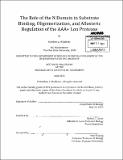The role of the N domain in substrate binding, oligomerization, and allosteric regulation of the AAA+ Lon protease
Author(s)
Wohlever, Matthew L
DownloadFull printable version (17.73Mb)
Other Contributors
Massachusetts Institute of Technology. Department of Biology.
Advisor
Robert T. Sauer.
Terms of use
Metadata
Show full item recordAbstract
For cells and organisms to survive, they must maintain protein homeostasis in varied and often harsh environments. Cells utilize proteases and chaperones to maintain their proteomes. In bacteria, most cytosolic proteolysis is performed by self-compartmentalized AAA+ proteases, which convert the chemical energy of ATP binding and hydrolysis into mechanical work to unfold and translocate substrates into an internal degradation chamber. Substrates are targeted to AAA+ proteases by degradation tags (degrons). In E. coli, the Lon protease is responsible for the degradation of numerous regulatory proteins, including the cell-division inhibitor SulA, but also recognizes and degrades the majority of misfolded proteins. How Lon recognizes and prioritizes such a vast array of substrates is poorly understood. Active Lon is a homohexamer in which each subunit contains an N domain, a AAA+ module that mediates ATP binding and hydrolysis, and a peptidase domain. Degron binding allosterically regulates Lon activity and can shift Lon into conformations with higher or lower protease activity, but the mechanistic basis of this regulation is unknown. The low-protease conformation of Lon may serve as a chaperone. In Chapter 2, I describe the development and characterization of fluorescent model substrates that Lon degrades in vitro and in vivo. In Chapter 3, I describe collaborative experiments that show that Lon equilibrates between a hexamer and a dodecamer. Based on biochemical analysis and a low-resolution EM dodecamer structure, Lon appears to shift its substrate profile by changing oligomeric states and contacts between N domains appear to stabilize the dodecamer. In Chapters 4 and 5, 1 identify a binding site for the sul20 degron (isolated from SulA) in the Lon N domain and demonstrate that substrate binding to this site allosterically regulates protease and ATPase activity. I also show that the E240K mutation in the N domain alters Lon activity and stabilizes dodecamers. Finally, I provide evidence that E. coli Lon can act as a chaperone in vivo. These experiments demonstrate that the N domain integrates substrate binding, oligomerization, and regulation of the catalytic activities of Lon.
Description
Thesis (Ph. D.)--Massachusetts Institute of Technology, Dept. of Biology, June 2013. "June 2013." Cataloged from PDF version of thesis. Includes bibliographical references.
Date issued
2013Department
Massachusetts Institute of Technology. Department of BiologyPublisher
Massachusetts Institute of Technology
Keywords
Biology.